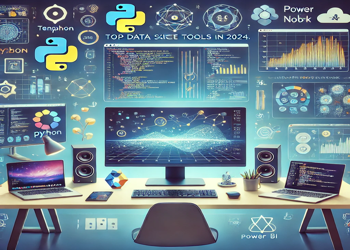
Top Data Science Tools in 2024: Essential Software Every Data Scientist Should Know
In the evolving world of technology, data science tools are essential for professionals looking to extract insights and value from large datasets. Whether you're just starting or are an experienced data scientist, having the right *data science software* in your toolkit can make a huge difference. In 2024, these are the top data science tools for efficient data processing, analysis, visualization, and machine learning.
1. Python
Python will remain the backbone of data science software in 2024. Known for its simplicity and flexibility, it provides a vast collection of libraries, such as Pandas for data manipulation, NumPy for mathematical operations, and Matplotlib for visualization. Its extensive community support and straightforward syntax make Python a top choice for both beginners and seasoned data scientists.
Why Use Python?
- Ideal for data analysis, statistical modeling, and machine learning
- Offers versatile libraries tailored for data science workflows
- Extensive online resources and active community support
2. R Programming
R is another popular tool among statisticians and data scientists. Built specifically for data analytics, R excels in statistical modeling and visualization. It has packages like ggplot2 for high-quality graphs, dplyr for data manipulation, and caret for machine learning. For anyone focused on research and in-depth statistical analysis, R is invaluable.
Why Use R?
- Specialized in statistical analysis and visualization
- Robust packages for data wrangling and machine learning
- Extensive support for reproducible research
3. Jupyter Notebook
For a seamless coding experience, Jupyter Notebook allows data scientists to combine code, output, and markdown in one place, making it an excellent tool for exploratory data analysis. Its interactive platform is highly favored for documenting and sharing code, particularly in collaborative environments.
Why Use Jupyter Notebook?
- Ideal for prototyping and interactive data exploration
- Easy-to-use interface for documenting and visualizing results
- Great for sharing notebooks in collaborative projects
4. TensorFlow
When it comes to machine learning and deep learning, TensorFlow by Google is one of the *top data science tools* in 2024. It provides a flexible platform to build and deploy machine learning models, with support for deep neural networks, convolutional neural networks, and more.
Why Use TensorFlow?
- Powerful library for machine learning and deep learning models
- Widely adopted for building and deploying production-grade AI models
- Large community and extensive documentation
5. Apache Spark
Spark is an essential tool for data scientists working with big data. Its real-time processing capabilities and compatibility with multiple programming languages, including Python, Scala, and Java, make it a preferred choice for big data analytics. Spark's speed and efficiency in handling large datasets make it indispensable for companies handling massive data streams.
Why Use Apache Spark?
- Exceptional for big data processing and analytics
- Real-time data streaming capabilities
- Integrates with Hadoop and other big data frameworks
6. Tableau
Tableau remains a leader in data visualization software. Known for its ability to create interactive, visually appealing dashboards, Tableau enables data scientists to turn complex datasets into understandable visuals. Its drag-and-drop interface allows even non-technical users to create powerful visual insights, making it a favorite for presenting data to stakeholders.
Why Use Tableau?
- User-friendly for creating interactive dashboards
- Excellent integration with multiple data sources
- Ideal for data visualization and storytelling
7.Power BI
Microsoft’s Power BI is another powerful tool for data visualization. With seamless integration with Microsoft’s ecosystem, Power BI is a go-to for organizations using Microsoft products. It offers both on-premises and cloud-based options, making it highly versatile for various business needs.
Why Use Power BI?
- Best for users within the Microsoft ecosystem
- Offers both desktop and cloud-based visualization options
- Affordable and scalable for different-sized organizations
8. KNIME
KNIME (Konstanz Information Miner) is an open-source tool that allows for end-to-end data science workflows. It supports a drag-and-drop interface for creating data workflows, integrating with languages like Python and R. KNIME is particularly useful for data preprocessing, ETL (extract, transform, load) operations, and predictive analytics.
Why Use KNIME?
- Open-source, user-friendly drag-and-drop interface
- Great for building comprehensive data science workflows
- Integrates seamlessly with other programming languages
9. Hadoop
Hadoop remains a key player in the *data science tools* landscape, particularly for handling massive amounts of data. With its distributed storage and processing capabilities, Hadoop is often the backbone of big data architectures, enabling data scientists to store and process petabytes of data.
Why Use Hadoop?
- Essential for storing and processing large datasets
- Supports distributed computing and large-scale processing
- Forms the foundation of big data infrastructure
10. SQL
SQL is the classic data management language that will continue to be indispensable in 2024. Whether it's data extraction, transformation, or loading, SQL remains a fundamental skill for data scientists. With SQL, data can be accessed and manipulated efficiently, allowing data scientists to conduct quick queries on relational databases.
Why Use SQL?
- Foundational tool for querying and managing databases
- High speed and efficiency in data manipulation tasks
- Crucial for most data-related roles and database work
Conclusion
Choosing the right *data science tools* in 2024 depends on your specific goals and project needs. While Python and R are fundamental for data analysis, other tools like Spark, Hadoop, and KNIME are essential for big data. Visualization tools such as Tableau and Power BI bridge the gap between data scientists and stakeholders, making data insights accessible and impactful. By building a toolkit that combines these powerful *data science software* solutions, data scientists are well-equipped to handle the challenges of the modern data landscape.
So, whether you're a beginner or an experienced data scientist, mastering these *top data science tools in 2024* can help you streamline workflows, enhance productivity, and ultimately, succeed in the data science field.
Comments (0)
Categories
Recent posts
.png)
.png)
Demystifying Full Stack Development: A ...
5 Aug 2024
Better Relationship Between Friends
1 Jul 2021.png)
Full Stack Development Tools and ...
5 Aug 2024.png)




